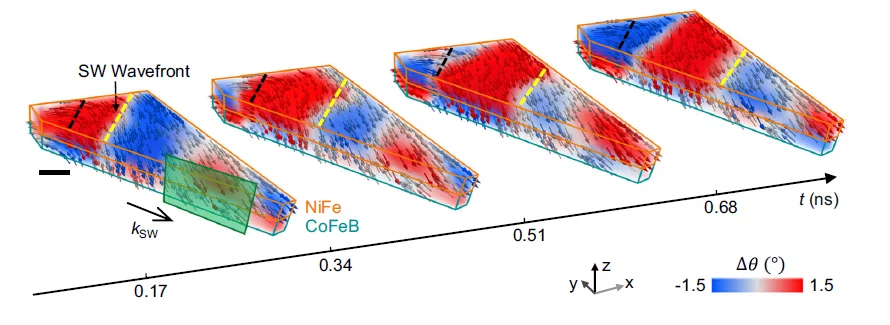Spin waves, and their corresponding magnon quasiparticle, are wave-like propagating perturbations of the spin configuration in a magnetic material. Spin waves exhibit several peculiar properties that make them of interest for applications in computing, telecommunications, and sensing, such as nanometer wavelengths at the GHz-THz frequency range (orders of magnitude smaller than corresponding electromagnetic waves, making them very promising for applications in miniaturized devices), and they do not exhibit Ohmic losses, meaning that a significant reduction in both heat dissipation and power consumption of magnonic devices can be achieved with respect to equivalent electromagnetic devices. In addition, the bosonic nature of magnon quasi-particles makes them very appealing for quantum-physics research, as room-temperature Bose-Einstein condensates of magnons have been demonstrated.
The rich phenomenology of spin wave perturbations is, due to the fact that the spins rotate in space, intrinsically three-dimensional. However, until now, the experimental investigation of magnonic processes could either be performed by indirect methods (such as e.g. light scattering and electrical transport measurements), or by two-dimensional time-resolved X-ray microscopy imaging, hindering the full investigation of this inherently three-dimensional process. Thanks to recent developments, pioneered at the Swiss Light Source, in time-resolved soft X-ray microscopy imaging of three-dimensional magnetic systems, an international collaboration of researchers from the Politecnico di Milano (Italy), the Paul Scherrer Institute, and the Max-Planck-Institut for chemical physics of solids (Germany) has been able to resolve the dynamics of the propagation of a spin wave in three-dimensions with nanoscale spatial resolution, and sub-ns temporal resolution, opening up the possibility to study and manipulate magnons within complex nanostructures and device geometries.
In the research work, published within Nature Communications, the team of researchers has imaged the distribution of different spin wave modes propagating throughout a nanopatterned synthetic antiferromagnetic structure, revealing three-dimensional interference effects, and unexpected depth-dependent spin profiles originating from the interlayer dipolar interaction present in the nanostructure. As a confirmation of the quality of the acquired time-resolved three-dimensional images, micromagnetic simulations, and theoretical calculations closely resemble the experimental results.
The experimental work was performed at the PolLux beamline (X07DA) of the Swiss Light Source, utilizing a combination of time-resolved scanning transmission X-ray microscopy at soft X-ray energies with laminographic imaging. By acquiring a set of time-resolved images of the magnon dynamics at different orientation angles of the sample with respect to the probing X-ray beam, a full three-dimensional image of the spin wave dynamics could be reconstructed. This setup is currently unique to the PolLux beamline, but several collaborative works between the Swiss Light Source, the MaxIV laboratory (Sweden), and the Bessy II light source (Germany) for the installation of soft X-ray laminography imaging are underway, and will provide the user community access to this technique even during the currently ongoing SLS 2.0 upgrade shutdown.
Contacts:
Prof. Edoardo Albisetti
Dipartimento di Fisica
Politecnico di Milano
E-mail: edoardo.albisetti@polimi.it
Prof. Daniela Petti
Dipartimento di Fisica
Politecnico di Milano
E-mail: daniela.petti@polimi.it
Dr. Jörg Raabe
Swiss Light Source
Paul Scherrer Institut
Telephone: +41 56 310 5193
E-mail: joerg.raabe@psi.ch
Original Publication:
Three-dimensional spin-wave dynamics, localization and interference in a synthetic antiferromagnet
Davide Girardi, Simone Finizio, Claire Donnelly, Guglielmo Rubini, Sina Mayr, Valerio Levati, Simone Cuccurullo, Federico Maspero, Jörg Raabe, Daniela Petti, and Edoardo Albisetti
Nature Communications 15, 3057 (2024), DOI:10.1038/s41467-024-47339-9
